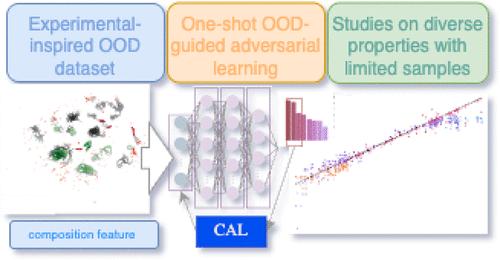使用对抗学习的非分布材料属性预测
IF 3.2
3区 化学
Q2 CHEMISTRY, PHYSICAL
引用次数: 0
摘要
准确预测材料特性对众多科学和工程学科都至关重要。机器学习(ML)推动了这一领域的技术发展,使科学家们能够发现新型材料,并设计出具有特定所需性能的材料。然而,在材料特性预测方面一直存在的一个重大挑战是,如何将模型泛化到分布外(OOD)样本,即与训练过程中遇到的样本有显著差异的样本。在现实世界的材料发现中,当应用 ML 预测源自少量实验样本的新探索区域内的其他材料时,经常会出现 OOD 情景。在本文中,我们将探索如何应用 OOD 学习方法的进步来增强材料属性预测模型的稳健性和可靠性。我们提出并将晶体对抗学习(CAL)算法应用于 OOD 材料属性预测,该算法在训练过程中生成合成数据,引导学习向那些预测不确定性较高的样本移动。我们进一步提出了一种基于对抗学习的针对性方法,使模型适应特定的 OOD 数据集,以替代传统的微调方法。我们的实验表明,我们的 CAL 算法在样本有限的 ML 场景中非常有效,而这种情况在材料科学中经常出现。我们的工作为改进 OOD 学习和材料性能预测迈出了重要一步,并突出了需要进一步探索和完善的领域。本文章由计算机程序翻译,如有差异,请以英文原文为准。

Out-of-Distribution Material Property Prediction Using Adversarial Learning
The accurate prediction of material properties is crucial in a wide range of scientific and engineering disciplines. Machine learning (ML) has advanced the state of the art in this field, enabling scientists to discover novel materials and design materials with specific desired properties. However, one major challenge that persists in material property prediction is the generalization of models to out-of-distribution (OOD) samples, i.e., samples that differ significantly from those encountered during training. In real-world materials discovery, OOD scenarios often arise when applying ML to predict additional materials within a newly explored region originating from a few experimental samples. In this paper, we explore the application of advancements in OOD learning approaches to enhance the robustness and reliability of material property prediction models. We propose and apply the Crystal Adversarial Learning (CAL) algorithm for OOD materials property prediction, which generates synthetic data during training to guide learning toward those samples with high prediction uncertainty. We further propose an adversarial learning-based targeted approach to make the model adapt to a particular OOD data set, as an alternative to traditional fine-tuning. Our experiments suggest that our CAL algorithm can be effective in ML scenarios with limited samples, which commonly occur in materials science. Our work provides an important step toward improved OOD learning and materials property prediction and highlights areas that require further exploration and refinement.
求助全文
通过发布文献求助,成功后即可免费获取论文全文。
去求助
来源期刊

The Journal of Physical Chemistry C
化学-材料科学:综合
CiteScore
6.50
自引率
8.10%
发文量
2047
审稿时长
1.8 months
期刊介绍:
The Journal of Physical Chemistry A/B/C is devoted to reporting new and original experimental and theoretical basic research of interest to physical chemists, biophysical chemists, and chemical physicists.
 求助内容:
求助内容: 应助结果提醒方式:
应助结果提醒方式:


